You have an Azure subscription that contains the resources shown in the following table.

You need to configure FW1 to filter traffic that originates from VNet1 and targets the FQDN of SQLDB1 Which type of rule should you use?
You have an on-premises datacenter.
You have an Azure subscription that contains 10 virtual machines and a virtual network named VNe1l in the East US Azure region. The virtual machines are connected to VNet1 and replicate across three availability zones.
You need to connect the datacenter to VNetl1by using ExpressRoute. The solution must meet the following requirements:
• Maintain connectivity to the virtual machines if two availability zones fail.
• Support 1000-Mbps connections-
What should you include in the solution? To answer, select the appropriate options in the answer area. NOTE: Each correct selection is worth one point.
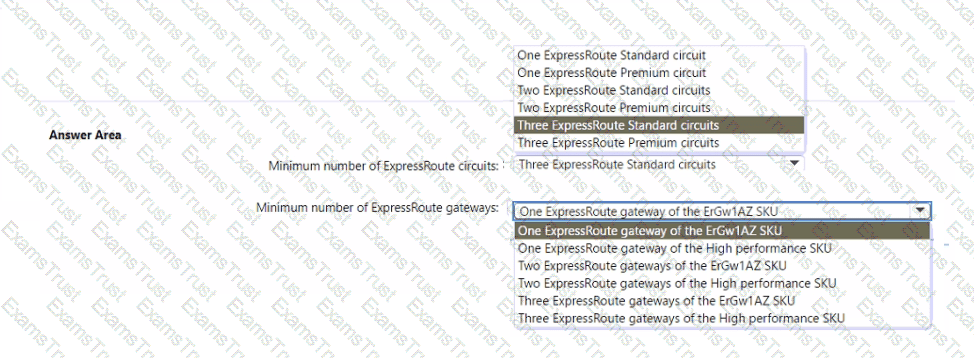
You have art Azure subscription.
You plan to deploy Azure Front Door with Azure Web Application Firewall (WAF).
You plan to implement custom rules and managed rules that meet the following requirements:
• Block malicious bots.
• Throttle client IP addresses that exceed 100 connections per minute.
You need to identify which Front Door SKU to configure, and which type of rule to configure for each requirement. The solution must minimize administrative effort and costs.
What should identify? To answer, drag the appropriate options to the correct targets. Each option may be used once, more than once, or not at all. You may need to drag the split bar between panes or scroll to view content.
NOTE: Each correct selection is worth one point.

Note: This question is part of a series of questions that present the same scenario. Each question in the series contains a unique solution that might meet the stated goals. Some question sets might have more than one correct solution, while others might not have a correct solution.
After you answer a question in this section, you will NOT be able to return to it. As a result, these questions will not appear in the review screen.
You have on Azure subscription that contains on Azure Virtual WAN named VWAN1.VWAN1 contains a hub named Hub1.
Hub! has a security status of Unsecured.
You need to ensure that the security status of Hub1 is marked as Secured.
Solution: You implement Azure Firewall.
Does this meet the requirement?
You have an Azure subscription that contains an Azure Front Door Premium profile named AFD1 and an Azure Web Application Firewall (WAF) policy named WAF1. AFD1 is associated with WAF1.
You need to configure a rate limit for incoming requests to AFD1.
Solution: You add a rule to the rule set of AFD1.
Does this meet the goal?
You have an Azure subscription that contains an Azure App Service web app named WebApp1 and an Azure Front Door profile named FDProfile1 FDProfile1 forwards requests addressed to to WebApp1.
You need to ensure that only requests addressed to forwarded to WebApp1.
What should you modify in FDProfile1?
You purchase an Azure subscription. You plan to deploy resources shown in the following table to then subscription.

You need to create a NSG1 rule named Rule1 to meet the following requirements:
* Enable the search servers of App1 to establish outbound HTTP connections to internet services.
* Minimize administrative effort when new search servers are deployed.
* Use the principle of least privilege.
What should you select as the source for Rule1?
You have an on-premises network.
You have an Azure subscription that contains the resources shown in the following table.

You need to implement an ExpressRoute circuit to access the resources in the subscription. The solution must ensure that the on-premises network connects to the Azure resources by using the ExpressRoute circuit.
Which type of peering should you use for each connection? To answer, select the appropriate options in the answer area.
NOTE: Each correct selection is worth one point.

You have the Azure resources shown in the following table.

You configure storage1 to provide access to the subnet in Vnet1 by using a service endpoint.
You need to ensure that you can use the service endpoint to connect to the read-only endpoint of storage1 in the paired Azure region.
What should you do first?
You have an Azure application gateway for a web app named App1. The application gateway allows end-to-end encryption.
You configure the listener for HTTPS by uploading an enterprise signed certificate.
You need to ensure that the application gateway can provide end-to-end encryption for App1. What should you do?
You have an Azure Front Door instance named FD1 that is protected by using Azure Web Application Firewall (WAF).
FD1 uses a frontend host named app1.contoso.com to provide access to Azure web apps hosted in the East US Azure region and the West US Azure region.
You need to configure FD1 to block requests to app1.contoso.com from all countries other than the United States.
What should you include in the WAF policy?
You have an Azure subscription that contains an Azure VPN gateway named GW1. GW1 provides Point-to Site (P2S) VPN connectivity.
Users connect to GW1 from a Windows 11 device by using an SSTP connection.
You need to ensure that the P2S VPN connections support Microsoft Entra authentication.
Which three actions should you perform in sequence? To answer, move the appropriate actions from the list of actions to the answer area and arrange them in the correct order.
NOTE: More than one order of answer choices is correct. You will receive credit for and of the correct orders you select.

You have an Azure subscription. The subscription contains a locally-redundant storage 1LRS) account named stoiage1 that is deployed to the US East Azure region and has a Microsoft Storage service endpoint.
You set Redundancy for storage 1 to Read-access geo-redundant storage (RA-GRS)
You need to ensure that the contents of storage1 will be accessible by using a service endpoint in a paired region. The solution must minimize administrative effort
What should you do first?
You have two Azure virtual networks named Hub1 and Spoke1. Hub1 connects to an on-premises network by using a Site-to-Site VPN connection.
You are implementing peering between Hub1 and Spoke1.
You need to ensure that a virtual machine connected to Spoke1 can connect to the on-premises network through Hub1.
How should you complete the PowerShell script? To answer, drag the appropriate values to the correct targets. Each value may be used once, more than once, or not at all. You may need to drag the split bar between panes or scroll to view content.
NOTE: Each correct selection is worth one point.

You have an Azure subscription that contains a virtual machine named VM1 and a network security group (NSG) named NSG1. NSG1 has the default rules configured VM1 runs Windows Server and contains a single NIC named NIC1 NIC! is associated with NSG1.
You need to prevent access to the Azure Instance Metadata Service (IMDS) REST API on VM1 The solution must minimize administrative effort.
What should you add to NSG1?
Your company has 10 instances of a web service. Each instance is hosted in a different Azure region and is accessible through a public endpoint.
The development department at the company is creating an application named App1. Every 10 minutes. App1 will use a list of end points and connect to the first available endpoint.
You plan to use Azure Traffic Manager to maintain the list of endpoints.
You need to configure a Traffic Manager profile that will minimize the impact of DNS caching.
What should you configure? To answer, select the appropriate options in the answer area.
NOTE: Each correct selection is worth one point.

You are planning an Azure Front Door deployment that will contain the resources shown in the following table.

Users will connect to the App Service through Front Door by using a URL of You obtain a certificate for the host name of .
You need to configure a DNS record for and upload the certificate to Azure. What should you do? To answer, select the appropriate options in the answer area. NOTE: Each correct selection is worth one point.

You have an Azure Front Door instance that provides access to a web app. The web app uses a hostname of
You have the routing rules shown in the following table.
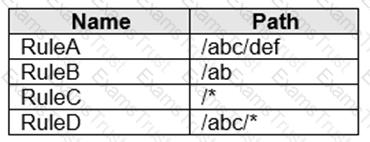
Which rule will apply to each incoming request? To answer, select the appropriate options in the answer area.
NOTE: Each correct selection is worth one point

ESTION NO: 1
You need to configure the default route on Vnet2 and Vnet3. The solution must meet the virtual networking requirements.
What should you use to configure the default route?
You need to configure the default route in Vnet2 and Vnet3. The solution must meet the virtual networking requirements.
What should you use to configure the default route?
You need to provide access to storage2. The solution must meet the PaaS networking requirements and the business requirements.
Which connectivity method should you use?
You need to restrict traffic from VMScaleSet1 to VMScaleSet2. The solution must meet the virtual networking requirements.
What is the minimum number of custom NSG rules and NSG assignments required? To answer, select the appropriate options in the answer area.
NOTE: Each correct selection is worth one point.
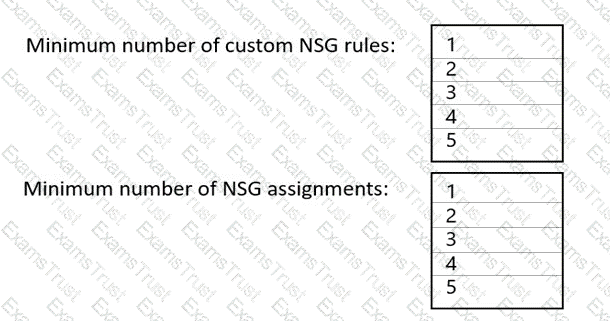
You need to implement outbound connectivity for VMScaleSet1. The solution must meet the virtual networking requirements and the business requirements.
Which three actions should you perform in sequence? To answer, move the appropriate actions from the list of actions to the answer area and arrange them in the correct order.
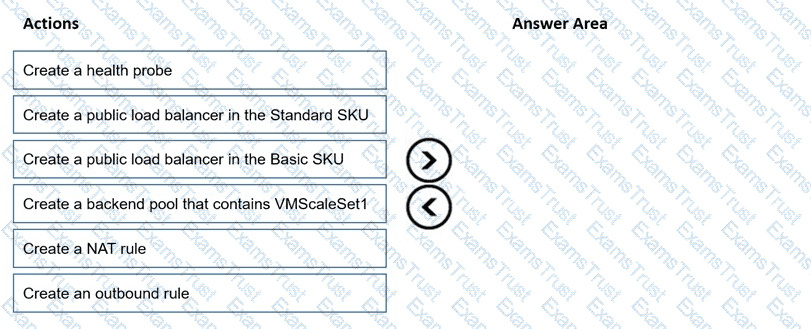
You need to recommend a configuration for the ExpressRoute connection from the Boston datacenter. The solution must meet the hybrid networking requirements and business requirements.
What should you recommend? To answer, select the appropriate options in the answer area.
NOTE: Each correct selection is worth one point.

You need to prepare Vnet1 for the deployment of an ExpressRoute gateway. The solution must meet the hybrid connectivity requirements and the business requirements.
Which three actions should you perform in sequence for Vnet1? To answer, move the appropriate actions from the list of actions to the answer area and arrange them in the correct order.

You need to provide connectivity to storage1. The solution must meet the PaaS networking requirements and the business requirements.
What should you include in the solution?
You need to connect Vnet2 and Vnet3. The solution must meet the virtual networking requirements and the business requirements.
Which two actions should you include in the solution? Each correct answer presents part of the solution.
NOTE: Each correct selection is worth one point.
You need to implement a P2S VPN for the users in the branch office. The solution must meet the hybrid networking requirements.
What should you do? To answer, select the appropriate options in the answer area.
NOTE: Each correct selection is worth one point.

You need to implement name resolution for the cloud.liwareinc.com. The solution must meet the networking requirements.
What should you do? To answer, select the appropriate options in the answer area.
NOTE: Each correct selection is worth one point.

You need to manage connectivity from NYCNet to the Azure services that use private endpoints. The solution must meet the security requirements. What should you do first?
You need to configure a security rule for APPGW1-NSG1. The solution must support the planned changes. Which service tag should you use?
You need to deploy Azure Virtual Network Manager. The solution must support the planned changes and meet the connectivity requirements.
Which four actions should you perform in sequence? To answer, move the appropriate actions from the list of actions to the answer area and arrange them in the correct order.
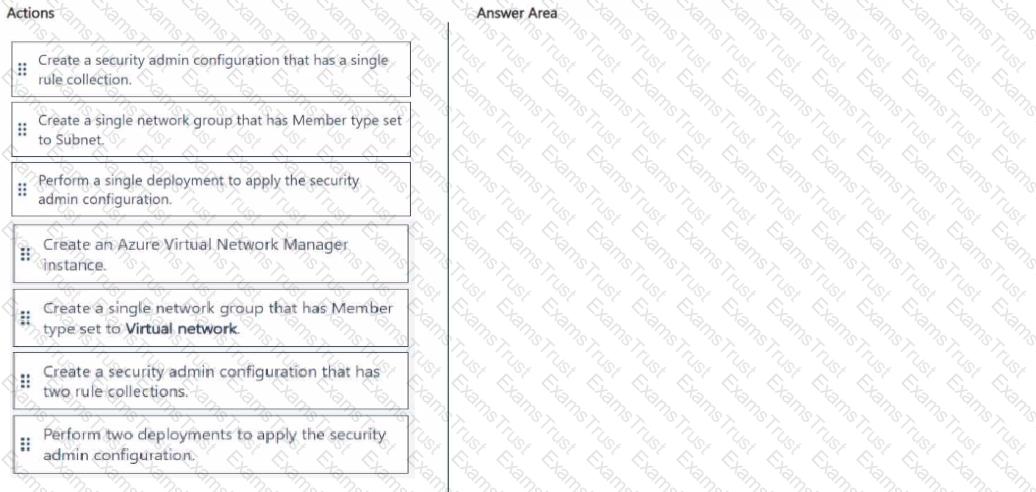
You need to configure FD1 to provide user access to app2.proseware.com. The solution must meet the security requirements and the general requirements.
What should you do first?
You need to identify which IP address space to allocate for the planned deployment of PRDNS1 to HubVNet and SpokeVNet. The solution must meet the general requirements
What should you identify for each virtual network? To answer, select the appropriate options in the answer area. NOTE: Each correct selection is worth one point.
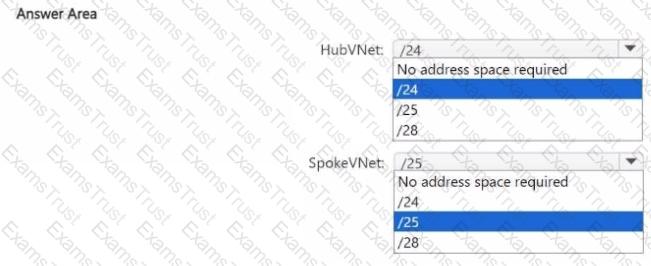
You need to configure the P2S VPN to meet the connectivity requirements.
What should you do? To answer, select the appropriate options in the answer area.
NOTE: Each correct selection is worth one point.

You need to configure connectivity between NYCNet and SFONet. The solution must meet the connectivity requirements. What should you do? To answer, select the appropriate options in the answer area. NOTE: Each correct selection is worth one point.

You are implementing the virtual network requirements for VM Analyze.
What should you include in a custom route that is linked to Subnet2? To answer, select the appropriate options in the answer area.
NOTE: Each correct selection is worth one point.
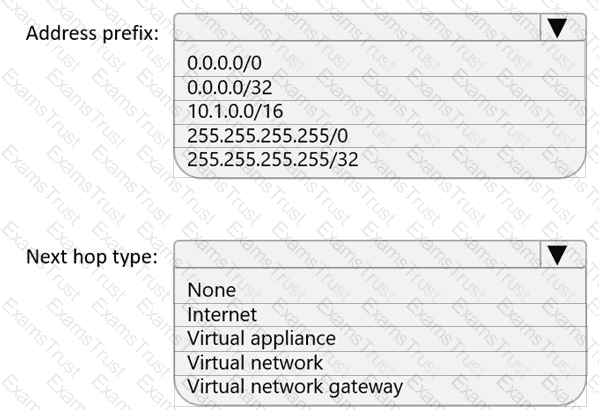
For each of the following statements, select Yes if the statement is true. Otherwise, select No.
NOTE: Each correct selection is worth one point.

What should you implement to meet the virtual network requirements for the virtual machines that connect to Vnet4 and Vnet5?
You create NSG10 and NSG11 to meet the network security requirements.
For each of the following statements, select Yes it the statement is true. Otherwise, select No.
NOTE: Each correct selection is worth one point.

You need to meet the network security requirements for the NSG flow logs.
Which type of resource do you need, and how many instances should you create? To answer, select the appropriate options in the answer area.
NOTE: Each correct selection is worth one point.

In which NSGs can you use ASG1 and to which virtual machine network interfaces can you associate ASG1? To answer, select the appropriate options in the answer area.
NOTE: Each correct selection is worth one point.

You need to configure GW1 to meet the network security requirements for the P2S VPN users.
Which Tunnel type should you select in the Point-to-site configuration settings of GW1?
You are implementing the Virtual network requirements for Vnet6.
What is the minimum number of subnets and service endpoints you should create? To answer, select the appropriate options in the answer area.
NOTE: Each correct selection is worth one point.

For each of the following statements, select Yes if the statement is true. Otherwise, select No.
NOTE: Each correct selection is worth one point.

Which virtual machines can VM1 and VM4 ping successfully? To answer, select the appropriate options in the answer area.
NOTE: Each correct selection is worth one point.
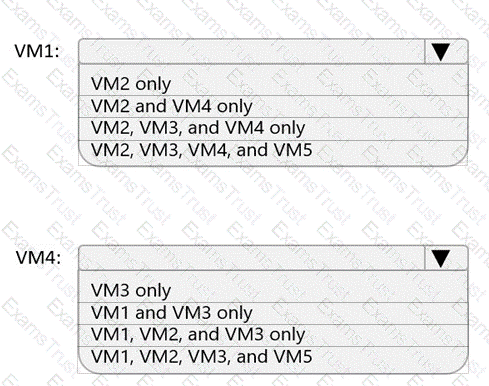
Task 6
You need to ensure that all hosts deployed to subnet3-2 connect to the internet by using the same static public IP address. The solution must minimize administrative effort when adding hosts to the subnet.
Task 8
You need to ensure that the storage34280945 storage account will only accept connections from hosts on VNET1
Task 9
You plan to use VNET4 for an Azure API Management implementation.
You need to configure a policy that can be used by an Azure application gateway to protect against known web attack vectors. The policy must only allow requests that originate from IP addresses in Canada. You do NOT need to create the application gateway to complete this task.
Task 10
You need to configure VNET1 to log all events and metrics. The solution must ensure that you can query the events and metrics directly from the Azure portal by using KQL.
Task 11
You are preparing to connect your on-premises network to VNET4 by using a Site-to-Site VPN. The on-premises endpoint of the VPN will be created on a firewall named Firewall 1.
The on-premises network has the following configurations:
• Internal address range: 10.10.0.0/16.
• Firewall 1 internal IP address: 10.10.1.1.
• Firewall1 public IP address: 131.107.50.60.
BGP is NOT used.
You need to create the object that will provide the IP addressing configuration of the on-premises network to the Site-to-Site VPN. You do NOT need to create a virtual network gateway to complete this task.
Task 7
You plan to deploy 100 virtual machines to subnet4-1. The virtual machines will NOT be assigned a public IP address. The virtual machines will call the same API. which is hosted by a third party. The virtual machines will make more than 10,000 calls per minute to the API.
You need to minimize the risk of SNAT port exhaustion. The solution must minimize administrative effort.
Task 1
You plan to deploy a firewall to subnetl-2. The firewall will have an IP address of 10.1.2.4.
You need to ensure that traffic from subnetl-1 to the IP address range of 192.168.10.0/24 is routed through the firewall that will be deployed to subnetl-2. The solution must be achieved without using dynamic routing protocols.
Task 2
You need to create an Azure Firewall instance named FW1 that meets the following requirements:
• Has an IP address from the address range of 10.1.255.0/24
• Uses a new Premium firewall policy named FW-pohcy1
• Routes traffic directly to the internet